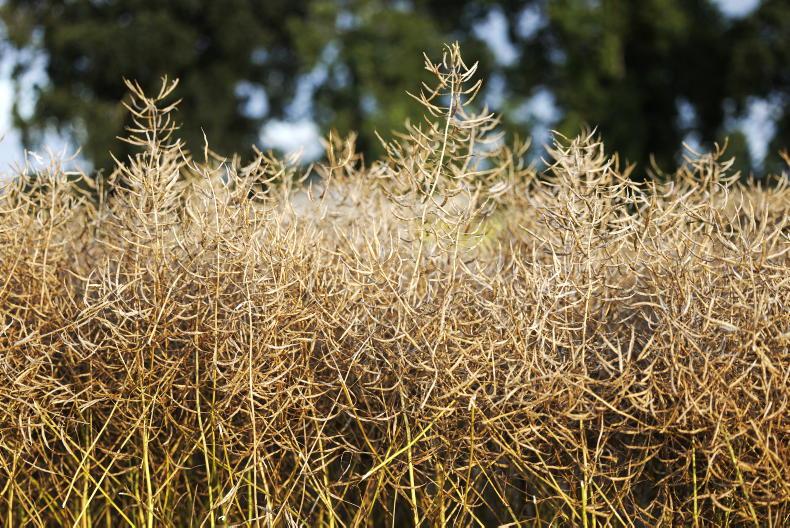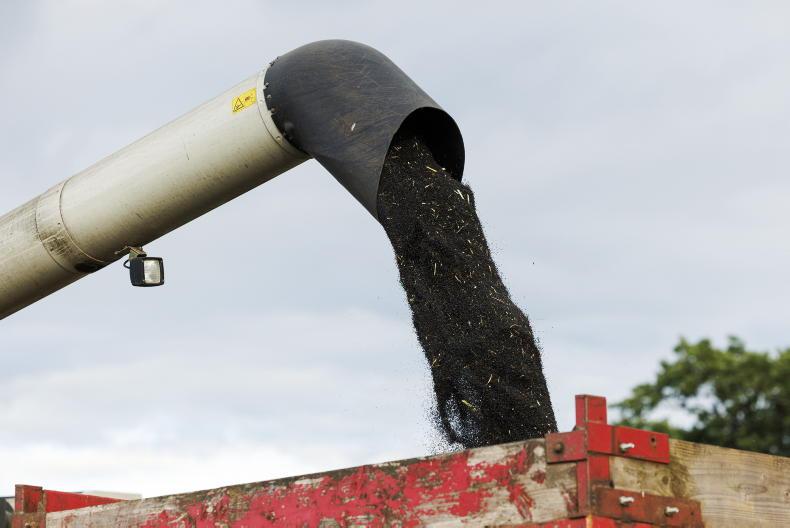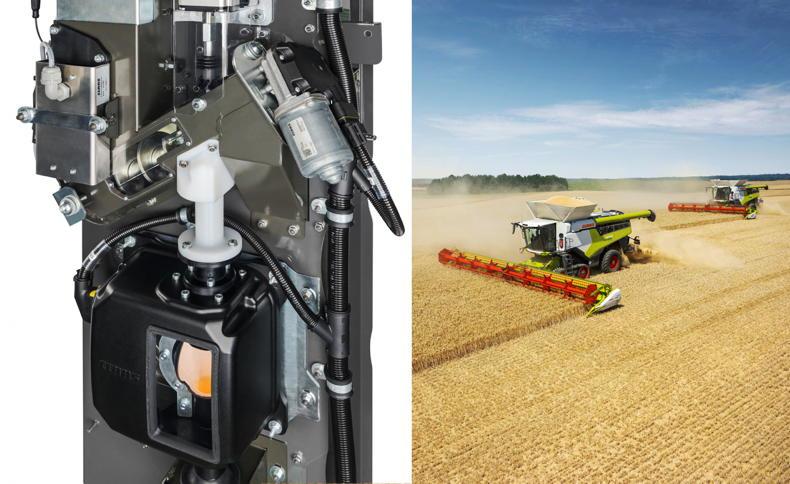This was one of the most remarkable harvests ever in terms of speed of harvest in most parts of the country and many very low moisture deliveries. This is good in many ways but there are catches too.
Ireland is one of the few countries where so much grain is traded off the combine at harvest. It is also one of the few countries where grain is traded at 20% moisture rather than dry or at 15% moisture having gone through a dryer.
Most farmers – sellers and buyers – will be aware that moisture content is basically water in grain which has no feeding value. Most will also be aware that grain needs some form of treatment to help keep it stable in storage. Options include:
Drying it to 15% moisture or lower.Treatment with a preservative such as acid.Applying enzyme-based products such as MycoCURB.Keeping the grain conditioned using air ventilation. When grain is below 15% moisture it is generally safe for storage, providing insect activity is prevented. Some countries use 13% as their trading standard and this is sometimes given favourable status when imported.
Energy intakes
Technically grain with lower moisture content and higher dry matter content is more valuable because it can lead to higher energy intakes in a diet. But this is not recognised in the industry and growers are only part compensated for weight loss down to 15% moisture. At even lower moistures the weight loss on the weighbridge receives no bonuses to even part compensate for this.
The fact that we trade at 20% moisture at harvest is partly because the majority of growers do not have the capacity to dry grain. This is partly because small traditional growers do not have surplus labour or facilities around harvest to justify a dryer.
The history of the 20% level may be linked to the fact that, taking one year with another, most of our grain is harvested at either side of 20% moisture.
Because we trade at 20% moisture our pricing regime has adjusted price up and down from 20% on an agreed basis. For many years this was set at €2.00/point but some merchants used €2.50/moisture point. In years when moistures are generally below 20% growers want the bonus to be bigger but in wet years growers need the deduction to be smaller. The adjustment moved to €3/moisture point this year.
If you take a single tonne of grain, any grain, at 20% moisture and you remove just one percentage point of moisture that tonne will lose weight. And if you remove five percentage points to get that grain down to 15% moisture you will lose much more of the initial weight of your tonne.
The formula for moisture adjusted weight is:
Table 1 shows the impact on the weight of a tonne of grain when its moisture level is altered from the base 20% value. Obviously the weight of a tonne will be higher when the moisture is above 20% and the weight will be lower when the moisture is lower.
At 23% moisture that basic tonne at 20% will weigh 1.039t or 39kg higher. At 15% moisture that 20% tonne will weigh 0.941t or 941kg. The difference in the weights is the moisture removed, which is 59kg. So the grower who delivers at 15% has 59kg less on which to be paid while the grower who delivered at 11% will have 101kg less than the 20% tonne will show on the weighbridge. Put this another way, a grower who delivered 100t at 11% moisture would have 10.112t not shown on the weighbridge dockets.
So if you bring in a tonne of grain at 20% moisture you will get the base price but when that tonne (1,000kg) is dried to 15%, its dry weight will be 941kg so the buyer has less weight to sell but the same amount of dry matter.
If the grower delivers at 17% moisture that tonne will receive an additional 3 x €3/t price bonus or an additional €9/t this year – this would have been €6/t last year. The lost weight is partly compensated for by the price alteration but is it enough?
Firstly, the price adjustment for moisture purely targets the weight loss and the value of the dry matter. Growers get paid more when the moisture is below the 20% base and less per tonne when it is above 20%. But do they marry up?
Take a 15% moisture delivery first. In this case the net delivery would be 0.941t at 15%, which is equivalent to 1t at 20%. Taking a base price of €300/t at 20% moisture, the 1t at 20% is worth €300 to the grower while the 941kg at €315/t (€300 + 5 x €3/t) is only worth €296.47/t so the value is less when the moisture is lower.
Take a farm example of the impact of moisture content on the net value of a 100t crop delivered at 20% moisture but adjusted to weights at a range of moisture levels. At 20% the 100t would be worth €30,000 to the grower.
However, at 23% that same field of grain would come into €30,233.77. At 15% the value to the grower is €29,647.06 while at 11% moisture (no extra price bonuses added below 15%) the crop value drops to €28,314.61 (see Table 2).
So it is costing money to deliver grain at lower moisture levels. At a price of €300/t it would take a €3.75 per moisture point adjustment to reward growers for the reduced weight in drier grain which requires less energy (carbon) to dry.
These weight loss adjustments and numbers are completely separate to drying cost.
Surely in this modern world of carbon accountability and sustainability, growers should be rewarded for practices which lower the carbon footprint of the industry rather than increase it.
This pricing system favours delivering wetter grain which needs more energy to dry it.
The model is telling growers to cut at higher moisture and let the buyer carry the cost of the fuel – that is surely nonsensical in today’s world.
This was one of the most remarkable harvests ever in terms of speed of harvest in most parts of the country and many very low moisture deliveries. This is good in many ways but there are catches too.
Ireland is one of the few countries where so much grain is traded off the combine at harvest. It is also one of the few countries where grain is traded at 20% moisture rather than dry or at 15% moisture having gone through a dryer.
Most farmers – sellers and buyers – will be aware that moisture content is basically water in grain which has no feeding value. Most will also be aware that grain needs some form of treatment to help keep it stable in storage. Options include:
Drying it to 15% moisture or lower.Treatment with a preservative such as acid.Applying enzyme-based products such as MycoCURB.Keeping the grain conditioned using air ventilation. When grain is below 15% moisture it is generally safe for storage, providing insect activity is prevented. Some countries use 13% as their trading standard and this is sometimes given favourable status when imported.
Energy intakes
Technically grain with lower moisture content and higher dry matter content is more valuable because it can lead to higher energy intakes in a diet. But this is not recognised in the industry and growers are only part compensated for weight loss down to 15% moisture. At even lower moistures the weight loss on the weighbridge receives no bonuses to even part compensate for this.
The fact that we trade at 20% moisture at harvest is partly because the majority of growers do not have the capacity to dry grain. This is partly because small traditional growers do not have surplus labour or facilities around harvest to justify a dryer.
The history of the 20% level may be linked to the fact that, taking one year with another, most of our grain is harvested at either side of 20% moisture.
Because we trade at 20% moisture our pricing regime has adjusted price up and down from 20% on an agreed basis. For many years this was set at €2.00/point but some merchants used €2.50/moisture point. In years when moistures are generally below 20% growers want the bonus to be bigger but in wet years growers need the deduction to be smaller. The adjustment moved to €3/moisture point this year.
If you take a single tonne of grain, any grain, at 20% moisture and you remove just one percentage point of moisture that tonne will lose weight. And if you remove five percentage points to get that grain down to 15% moisture you will lose much more of the initial weight of your tonne.
The formula for moisture adjusted weight is:
Table 1 shows the impact on the weight of a tonne of grain when its moisture level is altered from the base 20% value. Obviously the weight of a tonne will be higher when the moisture is above 20% and the weight will be lower when the moisture is lower.
At 23% moisture that basic tonne at 20% will weigh 1.039t or 39kg higher. At 15% moisture that 20% tonne will weigh 0.941t or 941kg. The difference in the weights is the moisture removed, which is 59kg. So the grower who delivers at 15% has 59kg less on which to be paid while the grower who delivered at 11% will have 101kg less than the 20% tonne will show on the weighbridge. Put this another way, a grower who delivered 100t at 11% moisture would have 10.112t not shown on the weighbridge dockets.
So if you bring in a tonne of grain at 20% moisture you will get the base price but when that tonne (1,000kg) is dried to 15%, its dry weight will be 941kg so the buyer has less weight to sell but the same amount of dry matter.
If the grower delivers at 17% moisture that tonne will receive an additional 3 x €3/t price bonus or an additional €9/t this year – this would have been €6/t last year. The lost weight is partly compensated for by the price alteration but is it enough?
Firstly, the price adjustment for moisture purely targets the weight loss and the value of the dry matter. Growers get paid more when the moisture is below the 20% base and less per tonne when it is above 20%. But do they marry up?
Take a 15% moisture delivery first. In this case the net delivery would be 0.941t at 15%, which is equivalent to 1t at 20%. Taking a base price of €300/t at 20% moisture, the 1t at 20% is worth €300 to the grower while the 941kg at €315/t (€300 + 5 x €3/t) is only worth €296.47/t so the value is less when the moisture is lower.
Take a farm example of the impact of moisture content on the net value of a 100t crop delivered at 20% moisture but adjusted to weights at a range of moisture levels. At 20% the 100t would be worth €30,000 to the grower.
However, at 23% that same field of grain would come into €30,233.77. At 15% the value to the grower is €29,647.06 while at 11% moisture (no extra price bonuses added below 15%) the crop value drops to €28,314.61 (see Table 2).
So it is costing money to deliver grain at lower moisture levels. At a price of €300/t it would take a €3.75 per moisture point adjustment to reward growers for the reduced weight in drier grain which requires less energy (carbon) to dry.
These weight loss adjustments and numbers are completely separate to drying cost.
Surely in this modern world of carbon accountability and sustainability, growers should be rewarded for practices which lower the carbon footprint of the industry rather than increase it.
This pricing system favours delivering wetter grain which needs more energy to dry it.
The model is telling growers to cut at higher moisture and let the buyer carry the cost of the fuel – that is surely nonsensical in today’s world.










SHARING OPTIONS